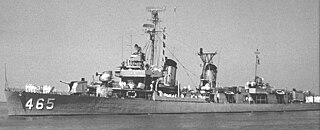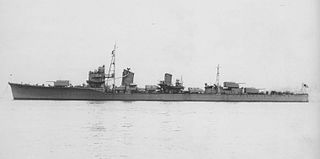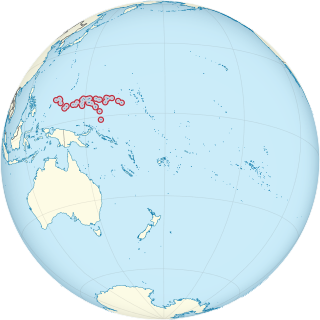
USS Saufley (DD/DDE/EDDE-465), a Fletcher-class destroyer, was a warship of the United States Navy named for pioneering Naval Aviator, Lieutenant Richard Saufley, USN.

USS Allen M. Sumner (DD-692), was the lead ship of her class of destroyers. The ship was named for Allen Melancthon Sumner, a United States Marine Corps captain, who was killed in action during World War I.

USS Pringle (DD-477), a Fletcher-class destroyer, was a ship of the United States Navy named for Vice Admiral Joel R. P. Pringle (1873–1932).

The Battle of Ormoc Bay was a series of air-sea battles between Imperial Japan and the United States in the Camotes Sea in the Philippines from 9 November-21 December 1944, at Ormoc, part of the Battle of Leyte in the Pacific campaign of World War II. The battles resulted from Japanese operations to reinforce and resupply their forces on Leyte and U.S. attempts to interdict them.

USS Moale (DD-693) was the second Allen M. Sumner-class destroyer of the United States Navy.

USS Caldwell (DD-605) was a Benson-class destroyer in the United States Navy during World War II. She was named for James R. Caldwell.
Wakatsuki (若月) was an Akizuki-class destroyer of the Imperial Japanese Navy. Her name means "Young Moon".

Naganami was a Yūgumo-class destroyer of the Imperial Japanese Navy.

Shimakaze was an experimental destroyer of the Imperial Japanese Navy during World War II, and intended as the lead ship in a projected new "Type C" of destroyers. She was the only destroyer to be armed with 15 torpedo tubes, each capable of firing the deadly 610 mm (24 in) Type 93 "Long Lance" torpedo. The ship also served as a testbed for an enormously powerful, high-temperature, high-pressure steam turbine that was able to develop 79,240 shp (59,090 kW). This made her one of the fastest destroyers in the world: her design speed was 39 knots, but on trials she made 40.9 knots.

Shortland Island is the largest island of the Shortland Islands archipelago, in the Western Province of Solomon Islands, at 7°3′S155°45′E.

USS Whitman (DE-24) was an Evarts-class destroyer escort constructed for the United States Navy during World War II. It was promptly sent off into the Pacific Ocean to protect convoys and other ships from Japanese submarines and fighter aircraft. By the end of the war, when she returned to the United States, she had accumulated four battle stars.

USS Richard S. Bull (DE-402) was a John C. Butler-class destroyer escort in service with the United States Navy from 1944 to 1946. She was finally sunk as a target in 1969.

USS Conklin (DE-439) was a John C. Butler-class destroyer escort in service with the United States Navy from 1944 to 1946. She was scrapped in 1972. Conklin (DE-439) was named in honor of George Emerson Conklin who was posthumously awarded the Navy Cross for his brave actions on Guadalcanal.
USS Cooper: Return to Ormoc Bay is a 2005 Philippine documentary film produced by Bigfoot Entertainment and directed by Daniel Foster. The film documents the fate of an American destroyer that was torpedoed during World War II.

USS Pavlic (APD-70) was built by Dravo Corporation at Pittsburgh, Pennsylvania as a Buckley-class destroyer escort. Pavlic was launched 18 December 1943 and towed to Texas for refitting as a United States Navy high-speed transport. Pavlic was in commission from 1944 to 1946, serving in the Okinawa campaign as a radar picket ship. Pavlic was decommissioned 15 November 1946. After more than 20 years of inactivity in reserve, she was stricken from the Navy List on 1 April 1967. On 1 July 1968, she was sold for scrapping to North American Smelting Company.
VPB-34 was a Patrol Bombing Squadron of the U.S. Navy. The squadron was established as Patrol Squadron 34 (VP-34) on 16 April 1942, redesignated Patrol Bombing Squadron 34 (VPB-34) on 1 October 1944 and disestablished on 7 April 1945.

VPB-52 was a Patrol Bombing Squadron of the U.S. Navy. The squadron was established as Torpedo Squadron 3D15 (VT-3D15) on 12 July 1928, redesignated Patrol Squadron 3-S (VP-3S) on 21 January 1931, redesignated Patrol Squadron 3 Base Force (VP-3F) on 17 July 1933, redesignated Patrol Squadron 3 (VP-3) on 1 October 1937, redesignated Patrol Squadron 32 (VP-32) on 1 July 1939, redesignated Patrol Squadron 52 (VP-52) on 1 July 1941, redesignated Patrol Bombing Squadron 52 (VPB-52) on 1 October 1944 and disestablished on 7 April 1945.

Take was one of 18 Matsu-class escort destroyers built for the Imperial Japanese Navy (IJN) near the end of World War II. Completed in mid-1944, the ship spent her short career escorting troop and supply convoys. She was damaged in the Battle of Ormoc Bay in early December and returned to Japan for repairs. Remaining in home waters for the rest of the war, she was modified to deliver Kaiten manned torpedoes in early 1945. Take was surrendered to the Allies at the end of the war and used to repatriate Japanese troops until 1947. Mid-year the destroyer was turned over to the United Kingdom and later scrapped.

Kuwa was one of 18 Matsu-class escort destroyers built for the Imperial Japanese Navy (IJN) during World War II. Completed in mid-1944, the ship played a minor role in the Battle off Cape Engaño in October and began escorting convoys the following month. She was sunk by American destroyers during the Battle of Ormoc Bay on 3 December. Kuwa probably sank one of the American ships with torpedoes before being sunk herself with the loss of about half her crew.

Naval Base Ulithi was a major United States Navy base at the Ulithi Atoll in the Caroline Islands in the western Pacific Ocean, to the north of New Guinea during World War II. The base was built to support the island-hopping Pacific War efforts of the Allied nations fighting the Empire of Japan. In terms of the number of ships at one base, Naval Base Ulithi was the largest naval base in the world in 1944 and 1945, with over 600 ships at times.


















